August 2008 // Volume 46 // Number 4 // Research in Brief // 4RIB5
Oregon WoodFest: Assessing the Educational Impact
Abstract
Oregon WoodFest had the goal of increasing awareness of Oregon citizens about the Oregon forest sector. The event featured two components: a continuing education course for architects and builders, and a public wood festival. This article reports the results of an assessment of the educational impact of Oregon WoodFest. Educational impact of Architectural Design with Wood was assessed using a post-test questionnaire and of the public festival using participant interviews. Results show that the CE course influenced participants' intentions regarding their use of wood and that the public festival increased participants awareness of wood and the forest sector.
Introduction
Determining outcomes of Extension events validates the effectiveness of Extension work and is important for all Extension educators. Successful evaluation of events not only helps justify the event to administration and funding agencies, it also helps event organizers plan more effectively for future events. This article presents an overview of a new Oregon State University (OSU) Extension Service event, Oregon WoodFest, and discusses event evaluation.
Event Overview
The forest products industry (hereafter referred to as the forest sector) is one of the most important industries in Oregon, accounting for approximately 47,000 jobs and $1.7 billion in payroll (OWIC, 2006). Forests cover approximately 27.5 million acres (45%) of Oregon (Hovee, 2004). Despite the importance of the forest sector to Oregon, the state's citizens are largely unaware of the positive economic role the forest sector plays.
In order to increase public awareness of the Oregon forest sector, the OSU Forestry Extension team organized WoodFest, based on an event observed during a Forestry Extension-led tour of Japan. The Japanese wood fair was held in a town of approximately 200,000 people and attracted approximately 60,000 attendees over a 2-day period, featuring family-focused, hands-on educational and wood craft activities, and a trade show featuring handmade wooden items.
WoodFest was held May 5-6, 2006 at the World Forestry Center in Portland, Oregon. The project had one overarching goal, to increase public appreciation for wood and its importance in the Oregon economy--put more simply, to promote a culture of wood. Accordingly, the objectives of the event were:
- Increase awareness and knowledge among Oregon citizens about wood and Oregon's forest sector,
- Increase knowledge among Oregon builders and architects about the proper use of wood and wood products in design and construction, and
- Increase sales of Oregon-based wood products.
WoodFest was proposed during OSU Forestry Extension's annual planning process (Garland & Adams, 1992). The project tied for the highest priority. A project leader was assigned, and Extension team members committed time to help plan and deliver the event.
The first step in organizing WoodFest was to study current events, including Goods from the Woods (Grand Rapids, Minnesota), Kentucky Wood Expo (London, Kentucky), and College of the Redwoods Wood Fair (Eureka, California). Organizers of these events were interviewed to learn from their collective experiences. Interviews covered event inception, growth, organizing committee composition and structure, and funding sources. Based on this background, the planning committee developed a concept for WoodFest and contacted potential partner organizations.
Funding from the Oregon Forest Resources Institute (OFRI) allowed hiring of a full-time project leader. In addition to OFRI funding was a Weyerhaeuser Foundation grant.
An initial meeting in Fall 2005 was held at the World Forestry Center. The concept was presented, and each attending organization indicated level of interest in the project. An executive organizing committee was formed including OSU Forestry Extension; The World Forestry Center; OFRI; The Guild of Oregon Woodworkers; and Andersen Wood Company, LLC.
Identifying target audiences as (1) architects and builders and (2) the public, the planning committee established two event components, (1) Architectural Design with Wood, a continuing education (CE) course for architects and builders, and (2) a public "wood festival."
Architectural Design with Wood
Architects and builders are important specifiers and users of building products. With wood being a major material used in residential construction in the U.S., it is important that these professionals understand wood. A CE course was designed with this outcome in mind.
A needs assessment determined what wood-related topics would be most useful. A list of potential topics was derived by the WoodFest executive committee and distributed to several civil engineers and architects who were asked to evaluate the list and add additional topics of interest. This resulted in inclusion of seven topics in the curriculum.
The course, held on May 5, 2006, at the World Forestry Center, featured 7 hours of educational content focused on the use of wood in architectural design. The specific topics of the course were as follows.
- Overview of Consortium of Research on Renewable Industrial Materials
- Life cycle analysis/life cycle inventory
- Improving deck ledgers and guardrail safety
- New products in wood construction: Design, use and specification
- Creativity in wood design
- Proper use of wood products
- Wood design for permanence
The 22 course attendees received 7 hours of CE credit from the American Institute of Architects (AIA).
Public Wood Festival
The public wood festival was held on May 6, 2006 at the World Forestry Center and included family-oriented educational activities and a trade show featuring the work of The Guild of Oregon Woodworkers. The Oregon Department of Forestry, OFRI, Talk About Trees, and Wood Magic (Garrard, Barnes, Seale, & Conners, 1999; Lockee, Pugh, & Zink-Sharp, 2003) provided educational displays. Fifteen Guild of Oregon Woodworkers members provided exhibits, including chainsaw carving, marquetry, and wood turners. Members of the public completing an Oregon WoodFest Quiz received free admission to the Discovery Museum. This quiz was composed of four questions relating to wood, with answers available at the educational booths, helping to ensure that people visit the educational booths prior to entering the museum. Based on the number of people entering the Museum, approximately 500 people attended the public event.
Event Evaluation
Architectural Design with Wood
The educational effect of Architectural Design with Wood was assessed using a post-test. At the conclusion of the event, participants were asked to complete a questionnaire used to determine how the content presented in the course affected intent to change behavior (Mazmanian, Daffron, Johnson, Davis, & Kantrowitz, 1998). Intention was assessed using a 6-point interval scale allowing responses to be grouped in three levels, those who disagreed (1-2); moderately agreed/disagreed (3-4); and agreed (5-6). A chi-square test (alpha = 0.05) was used to determine if responses differ from an even distribution among groups.
Six months after completion of the course, participants were emailed a follow-up questionnaire. The questionnaire was composed of yes/no questions assessing the impact of the course. Respondents were also asked to indicate how they had changed or why they had not changed based on the course material.
Public Festival
General public attendees were asked to participate in a semi-structured interview regarding WoodFest. Interviews were conducted by three OSU graduate students. Adult interviewees were randomly selected from all adult participants. In total, approximately 20% of adult participants were interviewed. Children of interviewed adults were given stickers so that families would not be approached by multiple interviewers.
The educational impact was assessed using the same methodology used for the CE course. A chi-square test (alpha = 0.05) was used to determine if the responses differ from that of an even distribution among groups.
Results
Architectural Design with Wood
All 22 participants were located within 2.5 hours of the Portland metropolitan area. Eighteen returned completed, useable questionnaires. Figures 1-5 show the effect the course had on intention to act.
The figures show that content presented in the course had an effect on intentions to act, with all participants agreeing they would alter the way they specify wood in their designs to account for moisture issues. The results of chi-square tests show that the responses to all questions, except considering life cycle assessment in design (Figure 3), were inconsistent with an equal distribution of responses among the three groups.
Figure 1.
I Intend to Alter the Way I Have Designed Deck Rails in the Past
to Incorporate What I Learned Today...
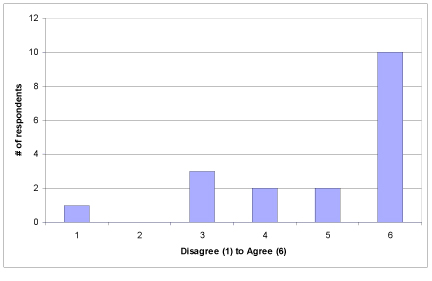
Figure 2.
Following What I Learned Today I Intend to Incorporate More Wood
Products Into My Designs...
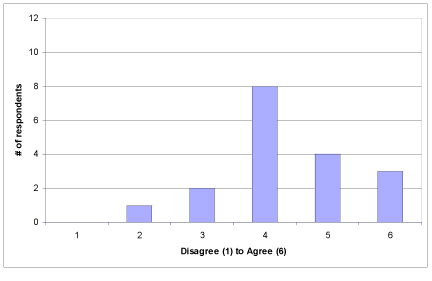
Figure 3.
I Will Consider Life Cycle Analysis Principles When Making Future
Decisions About the Materials I Specify...

Figure 4.
I Intend to Alter the Way I Have Used Engineered Wood Products to
Incorporate What I Learned Today...

Figure 5.
I Will Likely Alter the Way I Have Used Wood Products to Better
Control Moisture Based on What I Have Learned Today...
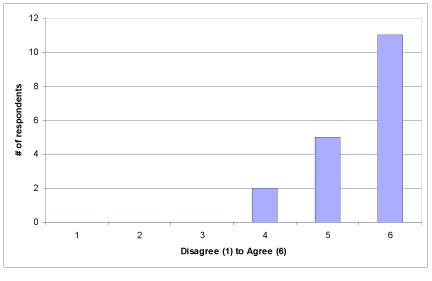
These results support the conclusion that course content affected participant intentions. Participants indicated they will alter deck railing design (Figure 1), incorporate more wood products (Figure 2), alter the use of engineered wood products (Figure 4), and alter the use of wood products to account for moisture issues (Figure 5).
Public Festival
A total of 31 semi-structured interviews were performed, representing 102 people (average group size of 3.3 people) representing approximately 20% of public festival attendees.
Figures 6-8 show the semi-structured interview results. Respondents agree that the public wood festival increased their awareness and understanding of wood and the Oregon forest sector. The results of chi-square tests show that responses were inconsistent with an equal distribution among the categories. Overall, respondents were significantly more likely to agree with questions regarding their awareness and understanding of wood and the Oregon forest sector.
Figure 6.
WoodFest Increased My Awareness of Wood...
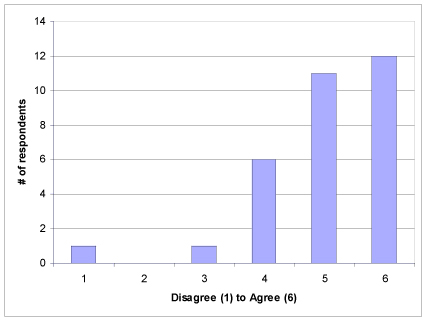
Figure 7.
WoodFest Increased My Awareness of the Oregon Forest Products
Industry...

Figure 8.
WoodFest Affected My Understanding of the Industry...
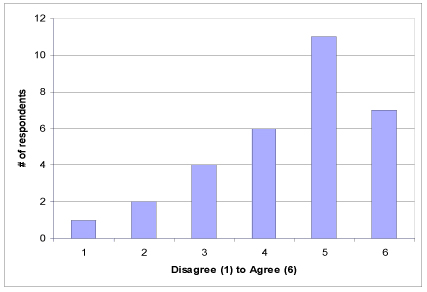
Quantitative results are reinforced with anecdotal comments made by interviewed participants. The following comments are representative of how respondents felt WoodFest affected their understanding of wood:
"… hands-on activities were helpful to let me know what was going on."
"… gave me an opportunity to learn and ask questions."
The comments showed that participants enjoyed the hands-on educational activities and felt the activities were effective in conveying information about wood's properties and uses.
Additionally, comments regarding the importance of the forest sector to Oregon show that participants' impressions and understanding of the forest sector were affected:
"… I wasn't aware of all of the industry's contributions"
"… the earlier we learn, the earlier we can support our industry and state university"
These comments, combined with the results of the structured questions, show the event was successful in helping participants understand and appreciate the forest sector's importance to the health of Oregon's economy.
To assess the effectiveness of event promotion, respondents were asked how they learned of the event. Promotion channels included newspapers, newsletters from organizations representing the executive committee, and flyers distributed at Oregon AgFest. Newspaper advertising was the most effective alternative, with 39% of respondents indicating they learned about WoodFest through these advertisements. This finding surprised the executive committee, who thought that newsletters would be the most effective promotion tool. In fact, only two of the 31 respondents indicated they learned about the event from newsletters.
Six-Month Follow-Up: Architectural Design with Wood
Of the 22 course participants, 18 responded to the 6-month follow-up impact assessment. The results are presented in Table 1.
| Question | Yes | No |
| Since attending the Architectural Design with Wood session, I have incorporated additional safety factors into the deck railings I have designed. | 5 | 13 |
| Since attending the Architectural Design with Wood session I have incorporated wood into my designs where previously I would not have. | 3 | 15 |
| Since attending the Architectural Design with Wood session I have altered the way I use engineered wood products to better reflect the intended uses of the products. | 5 | 13 |
| Since attending the Architectural Design with Wood session I have altered the way I use wood products to better control moisture. | 6 | 12 |
| Since attending the Architectural Design with Wood session I have used wood in more unique ways to create more innovative and more proactive architecture. | 2 | 16 |
| Since attending the Architectural Design with Wood session I have incorporated the principles of life cycle analysis when deciding what materials to specify. | 3 | 15 |
The follow-up impact assessment showed that the majority of course participants had not changed the way they used wood based on attending the course. The biggest change was seen with altering use of wood to control for moisture, with six respondents indicating they had made changes. However, it is important to note that when asked why changes had not been made, participants indicated that they had not had a chance to implement the information learned in the course because their ongoing and new projects did not involve wood. Several of the participants who had not implemented the course material indicated they planned to integrate the information into future projects.
The follow-up impact assessment shows the importance of customizing the assessment approach based on the characteristics of the course participants. Architectural projects often take multiple years to complete. Consequently, the 6-month follow-up used for this course may not have allowed sufficient time passage to accurately assess the long-term impact of the course.
Lessons Learned
After successful event completion, the executive committee debriefed and determined additional activities that could be added for future events.
Architectural Design with Wood
All feedback indicates interest in CE courses for architects and builders focusing on wood in design-related topics. Participants in the course indicated that AIA members must obtain two types of CE credits and offering both types of credits would attract more participants. Participants noted that the course was not adequately advertised and helped identify additional venues for event promotion.
Public Festival
Portland offers multiple events almost every weekend targeting the same audience as WoodFest. This makes it difficult to initiate a successful new event. The World Forestry Center is located in Washington Park, adjacent to the Oregon Zoo and the Children's Museum. On the day of WoodFest, the Oregon Zoo was hosting an event, and there was a large Cinco de Mayo celebration being held on the Portland waterfront. During the post-event debriefing, it was decided that this event would be a nice kick-off to arbor week, which occurs during a time of year when there are fewer events to compete with.
Comments from interviewed participants indicated a preference for more hands-on and interactive activities, especially targeted at children. Suggestions included face painting, a woodworking project (i.e., birdhouse building), and wood/tree identification. Participants also indicated they would like more representation from green/environmental groups. Healthy Forests, Healthy Communities, "a non-profit network of businesses in the Pacific Northwest committed to making the highest quality products from wood selected in ways that maintain or restore the health of our forests" (Healthy Forests, Healthy Communities 2006), was the only group of this type in attendance.
Finally, the executive committee identified a need to separate "hands-on" booths from "hands-off" booths. The booth layout at the event had "hands-off" booths of the members of the Guild of Oregon Woodworkers surrounded by "hands-on" educational booths. Some exhibitors expressed concern about children handling valuable, for-sale products. At future events, these two types of booths should be separated to alleviate this problem.
Conclusions
Evaluating WoodFest provided information supporting the idea that educational content can be effectively delivered to adults and families using the methods outlined above. This model is highly adaptable and can be used to organize similar events in other parts of the country.
Acknowledgements
The authors would like to acknowledge the following groups for their help in funding, planning, and making WoodFest a success: Oregon Forest Resources Institute, Weyerhaeuser, OSU Forestry Extension, The World Forestry Center, The Guild of Oregon Woodworkers, and Andersen Wood Company, LLC.
References
Garland, J. J., &. Adams, P.W. (1992). Coordinated tactical program planning among specialists and agents: The Oregon Extension Forestry experience. Journal of Natural Resources and Life Sciences Education. 21(1): 64-69.
Garrard, A. W., Barnes, H. M., Seale, R. D., & Conners, T. E. (1999). Wood Magic Science Fair. Forest Products Journal. 49(2): 10-15.
Healthy Forests, Healthy Communities. (2006). Retrieved July 27, 2006 from: http://www.hfhcp.org/
Hovee, E. D., & Company. (2004). Oregon forest sector contributions and potential. Report prepared for the Oregon Forest Resources Institute. June 2004. 61 pp.
Lockee, B. B., Pugh, C. E., & Zink-Sharp, A. (2003). Wood magic at a distance. Forest Products Journal. 53(9): 6-14.
Mazmanian, P. E., Daffron, S. R, Johnson, R. E., Davis, D. A., & Kantrowitz, M. P. (1998). Information about barriers to planned change: A randomized controlled trial involving continuing medical education lectures and commitment to change. Academic Medicine. 73(8): 882-886.
Oregon Wood Innovation Center (OWIC). (2006). About Oregon's forest products industry. Retrieved July 27, 2006 from: http://owic.oregonstate.edu/industry.php#cont
